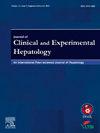人工智能在MASLD、肝细胞癌和数字病理学中的预测诊断、预后和决策支持
IF 3.2
Q2 GASTROENTEROLOGY & HEPATOLOGY
Journal of Clinical and Experimental Hepatology
Pub Date : 2025-09-06
DOI:10.1016/j.jceh.2025.103184
引用次数: 0
摘要
人工智能(AI)通过增强疾病诊断、风险分层和决策支持,从根本上改变了肝病学的格局。在代谢功能障碍相关的脂肪变性肝病(MASLD)中,人工智能已被整合到大型联盟中,如NIMBLE、LITMUS、TARGET-NASH和SteatoSITE,以提高诊断准确性和患者管理。这些联盟利用人工智能来推导和验证纤维化分期的非侵入性生物标志物。基于人工智能的模型还增强了肝细胞膨胀和代谢功能障碍相关脂肪性肝炎的检测,最大限度地减少了观察者之间的差异,并改善了临床试验的入组标准。此外,人工智能应用程序通过肠道微生物组和代谢谱来区分MASLD与酒精相关的肝脏疾病。在肝细胞癌(HCC)中,人工智能改善了风险分层、诊断和预后。基于肝脏硬度和临床参数的人工智能驱动模型可以对HCC发展的患者进行风险分层。人工智能增强的成像技术、放射组学和组织病理学提高了检测不确定肝结节和预测微血管侵袭的准确性。人工智能还可以改善经动脉化疗栓塞(TACE)和免疫检查点抑制剂等疗法的治疗反应预测,从而使治疗策略个性化,提高生存结果。在数字病理学中,人工智能重新定义了纤维化分期、供肝脂肪变性评估和疾病诊断。FibroNest™和qFibrosis是两个卓越的人工智能平台,它们利用成像技术来标准化组织学评估,并提高诊断精度。MASLD、HCC和数字病理学领域正朝着精准医学的方向发展。FibroNest™和qFibrosis是两个卓越的人工智能平台,它们利用成像技术来标准化组织学评估,并提高诊断精度。本文章由计算机程序翻译,如有差异,请以英文原文为准。
Artificial Intelligence for Predictive Diagnostics, Prognosis, and Decision Support in MASLD, Hepatocellular Carcinoma, and Digital Pathology
Artificial intelligence (AI) has fundamentally transformed the landscape of hepatology by enhancing disease diagnosis, risk stratification, and decision support. In metabolic dysfunction–associated steatotic liver disease (MASLD), AI has been integrated into large-scale consortia such as NIMBLE, LITMUS, TARGET-NASH, and SteatoSITE to improve diagnostic accuracy and patient management. These consortia utilize AI to derive and validate non-invasive biomarkers in fibrosis staging. AI-based models also enhance the detection of hepatocyte ballooning and metabolic dysfunction–associated steatohepatitis, minimizing interobserver variability and improving clinical trial enrollment criteria. Additionally, AI applications differentiate MASLD from alcohol-associated liver disease using gut microbiome and metabolic profiling.
In hepatocellular carcinoma (HCC), AI has improved risk stratification, diagnosis, and prognostication. AI-driven models based on liver stiffness and clinical parameters can risk stratify patients for HCC development. Enhanced imaging techniques, radiomics, and histopathology powered by AI improve the accuracy of detecting indeterminate liver nodules and predicting microvascular invasion. AI also improves treatment response prediction for therapies such as transarterial chemoembolization (TACE) and immune checkpoint inhibitors and thereby individualizes therapeutic strategies and improves survival outcomes.
In digital pathology, AI has redefined fibrosis staging, donor liver steatosis assessment, and disease diagnosis. FibroNest™ and qFibrosis are two exceptional AI platforms that utilize imaging techniques for the purposes of both standardizing histological assessments, as well as increasing diagnostic precision. The field of MASLD, HCC, and digital pathology is advancing towards precision medicine.
FibroNest™ and qFibrosis are two exceptional AI platforms that utilize imaging techniques for the purposes of both standardizing histological assessments, as well as increasing diagnostic precision.
求助全文
通过发布文献求助,成功后即可免费获取论文全文。
去求助
来源期刊

Journal of Clinical and Experimental Hepatology
GASTROENTEROLOGY & HEPATOLOGY-
CiteScore
4.90
自引率
16.70%
发文量
537
审稿时长
64 days
 求助内容:
求助内容: 应助结果提醒方式:
应助结果提醒方式:


